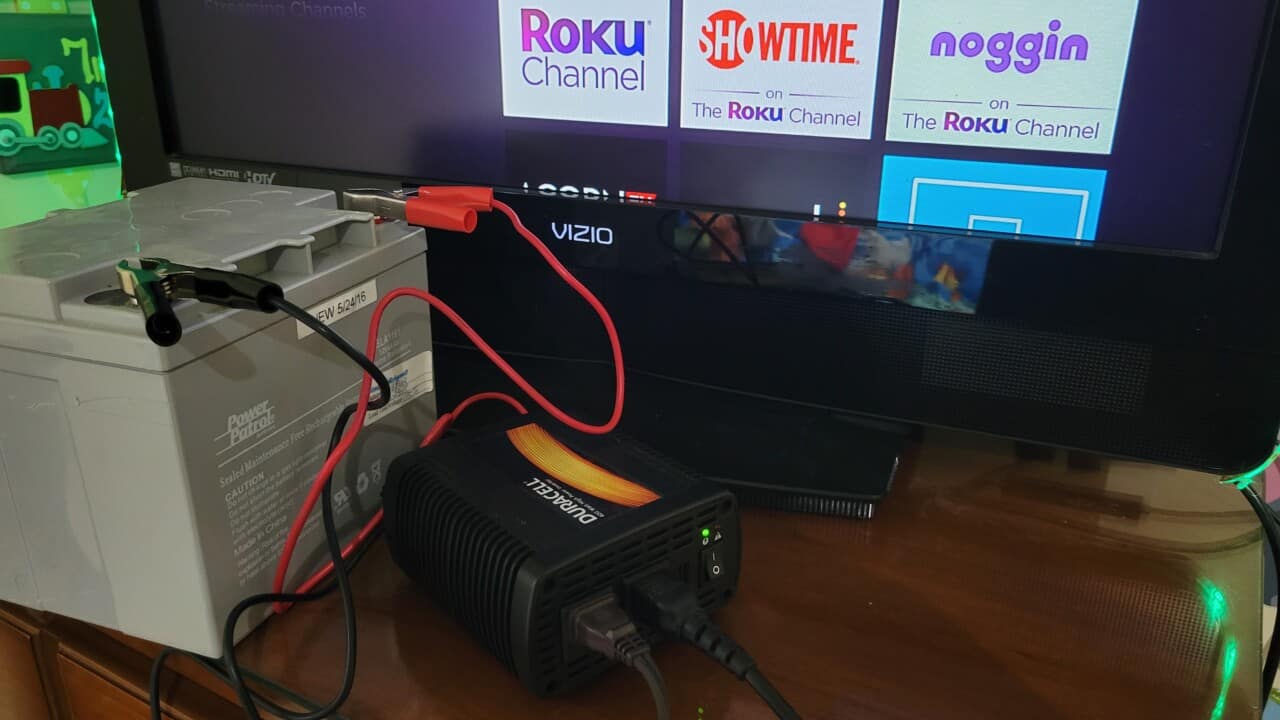If you find yourself in a power outage, tailgating, or camping, then powering a TV with a car battery may seem like a decent idea for some entertainment.
You’ve probably got a few questions about the process, like can a car battery even power a TV? How long can it power a TV? Is it safe to power a TV from a car battery?
Let’s keep this simple and to the point to get you on your way!
Listen to the article below by hitting the play button below and feel free to scroll the page for any helpful visuals. All of the articles on this website will have this audio feature for your convenience.
Can a Car Battery Power a TV?
A car battery is capable of powering a household TV when an inverter is used to convert the battery’s DC power into AC power. If using a DC powered travel TV, then a simple DC plug adapter is needed.
Car batteries are 12-volts and have DC (direct current) power. The receptacles in your house are 120-volts of AC (alternating current) power. That’s why an inverter (like this one seen on Amazon) must be used to make the electricity acceptable for the TV’s AC power cord.
An inverter is simply hooked up to the battery’s terminals with alligator clips, turned on, and then the TV is plugged into the inverter.

Not all inverters are created equal. Cheaper inverters are modified sine wave and have choppy sine waves if you were to plot them out on a graph. Basically, the electricity is in AC form for the TV but the electricity is “dirty” for lack of a better term. It’s not refined like it would be if it were coming from your household outlets.
Can a modified sine wave inverter power a TV? Sure, but you’ll likely experience harmonic distortions with sound and picture. I hear a high pitch but barely audible sound when I use a modified sine wave inverter on my TVs. It’s almost like a dog whistle or bad tinnitus.
Also, there’s always the chance that a modified sine wave inverter can damage the sensitive electronics inside of your TV.
The better alternative is to use a pure sine wave inverter. These inverters basically replicate the electricity that comes from your wall outlets. These are definitely safe to use with your TV and you should not experience any of the picture or sound quality issues.
If your TV has a DC plug on it (that you would plug into a cigarette lighter port on your car), then all you need is an adapter like this one (Amazon) and you’ll be in business without the need for an inverter.
How Long Can a Car Battery Power a TV?
In theory, a typical car battery can power a small TV for about 20 hours until the battery is dead. Factors including the battery’s age, health of each of the 6 individual cells, starting voltage, electrolyte levels, etc., are all variables which can affect the total time.
Your average modern household TV these days is going to use about 30-70 watts depending on its size. That’s just for the TV alone — not any streaming device, cable box, DVD player, router, modem, etc. You can use a “Kill a Watt meter” (Amazon) to easily see how much your particular TV uses.
Inverters have a 10-20% inefficiency factor as well, so for every 1 watt the TV uses, the inverter is actually pulling 1.11-1.25 watts from the battery to compensate for the loss of efficiency.
Car batteries generally run from 50-100Ah (amp hours) in equivalency. Generally, car batteries are rated in CCA or CA (cold cranking amps, or cranking amps) and not Ah (amp hours) because the CCA or CA rating will tell us how well the battery will perform at starting our engines at 0oF or 32oF. Car owners are generally not concerned with the Ah which will tell you how long you could power low-draw appliances off of it.
When we put it all together, we get a ballpark estimate of how long you can power a TV with a vehicle battery until the battery is dead. Be sure to divide these times in half so that you know when your battery is halfway dead.
| Battery/Vehicle Size | Small TV (30-Watts) | Medium TV (50-watts) | Large TV (70-Watts) |
|---|---|---|---|
| Small Car (50Ah) | 17 Hours | 10 Hours | 7 Hours |
| SUV, Van, Large Car (75Ah) | 25 Hours | 15 | 10 |
| Truck (100Ah) | 34 Hours | 20 | 14 |
Is it Safe to Power a TV with a Car Battery?
When using a pure sine wave inverter, it is perfectly safe for your TV to be powered with your car battery. However, car batteries were not designed for deep-cycle applications and their lifespan and effectiveness are quickly reduced when used as such. A designated deep-cycle battery, such as a marine or golf-cart batteries, would be the ideal method of powering a TV when conventional grid power is not available.
If you do decide to use your car battery to power a TV, it would be a good idea to start your car and let it run for 30 minutes or so every 60-90 minutes of watch time. Depending on your car battery’s age and state of health in each of its 6 cells, you are not really going to have any idea how low your battery can drain and still turn on your electronics and engage your car’s starter when you turn the key.
You might get away with starting your car at 40% state of charge with a new battery, but you might run into trouble at 70% with a battery that’s 5 years old.
A car battery was constructed with thin plates that are close together with lots of surface area. These plates are designed to give off a very high current on demand for up to 10 seconds or so for starting your engine — especially in cold weather. They easily acquire lead sulfate on the plates when they are not fully charged (or when they are used for deep-cycling).
Lead sulfate inhibits the charging process and also inhibits your battery’s ability to release as much amperage as it was designed to do. Your battery will get weaker and weaker with every deep-cycle application. If you run your battery down to nearly nothing, you can expect to only do this about a dozen times until your battery will be junk.
A deep-cycle battery, like those used on boats (make sure it’s deep-cycle and not dual-purpose) or golf carts, has thicker lead plates that are spaced farther apart and have less surface area. These are not intended to turn over an engine since the amperage doesn’t compare to a car’s starting battery. However, these are designed to go the distance when powering low draw appliances like a TV. Better yet, these batteries can be fully deep-discharged 150-250 times.
